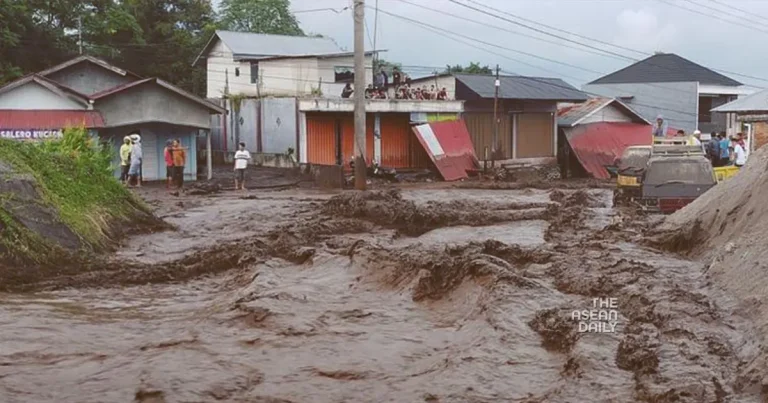13-5-2024 (JAKARTA) The catastrophic aftermath of flash flooding and volcanic mudflows in western Indonesia has taken a grim toll, with the death count soaring to 41 and 17 individuals still unaccounted for, according to a local disaster agency official. The tragic events unfolded over the weekend, as relentless downpours triggered massive volcanic rocks to cascade down the slopes of one of Indonesia’s most active volcanoes, Mount Marapi, engulfing two districts on the island of Sumatra.
Ilham Wahab, an official from the West Sumatra disaster mitigation agency, grimly conveyed the latest figures to AFP on Monday. “Data as of last night, we recorded 37 dead victims,” he stated solemnly, “But from this morning, it has grown again, the figure reached 41 (dead).”
The search for survivors remains a harrowing endeavour, with rescuers scouring the devastated areas for 17 individuals still missing – three in Agam district and a staggering 14 in Tanah Datar. These two districts, home to hundreds of thousands of residents, bore the brunt of the catastrophic flooding and the onslaught of volcanic debris.
Ilham Wahab could not provide a definitive count of those evacuated, as officials had encouraged locals to seek refuge with relatives in safer locations, rather than congregating in tent shelters amidst the relentless downpours. “We are focused on first, searching and rescuing the victims, second, protecting the evacuees, protecting the vulnerable people,” he emphasized, underscoring the urgency of the ongoing efforts.
The impact of the disaster has been devastating, transforming roads into raging rivers and leaving mosques and homes in shambles. Neighbourhoods were inundated with muddy floodwaters, vehicles swept into nearby rivers, and a terrifying cascade of volcanic ash and massive rocks thundered down the slopes of Mount Marapi.
This phenomenon, known as “cold lava” or “lahar,” is a deadly mixture of volcanic material such as ash, sand, and pebbles carried down a volcano’s slopes by the force of rainfall.
In the face of this calamity, authorities have mobilized teams of rescuers and dispatched rubber boats to search for the missing victims and transport survivors to shelters. The local government has established evacuation centres and emergency posts in several areas of Agam and Tanah Datar, providing refuge for those displaced by the disaster.
The national disaster mitigation agency (BNPB) reported extensive damage, with 84 homes, 16 bridges, and two mosques destroyed in Tanah Datar alone, along with 20 hectares of rice fields submerged.
Survivors recount harrowing tales of the ordeal they endured. Rina Devina, a housewife, recounted the terrifying sounds that preceded the disaster. “I heard the thunder and the sound similar to boiling water. It was the sound of big rocks falling,” she recalled, adding that three of her neighbours perished in the catastrophe.
“It was pitch black, so I used my cellphone as a flashlight. The road was muddy, so I chanted ‘God, have mercy!’ over and over again,” Devina shared, describing her desperate evacuation to a local official’s office.
Indonesia, an archipelago situated along the Pacific Ring of Fire, is tragically familiar with the perils of landslides and floods during the rainy season. In 2022, a similar disaster on Sumatra island resulted in the evacuation of approximately 24,000 people and the deaths of two children, with environmental campaigners attributing the severity of the event to deforestation caused by logging.




